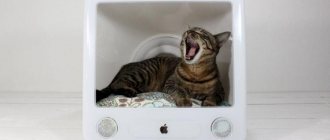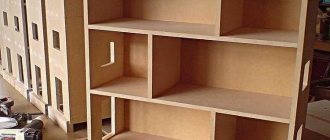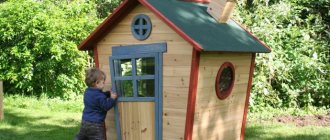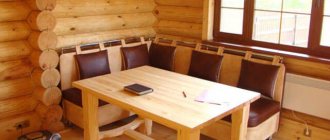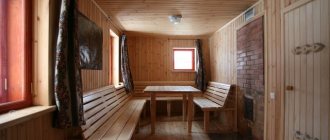Peculiarities
The cat house performs several functions:
- shelter - a place where you can hide from the other residents of the house;
- observation point - the pet should be able to view the maximum space around from it;
- a warm, cozy nest where you can sleep or just lie down and soak up;
- play area with scratching post , ribbons, tunnels and other play accessories.
An original house for a cat
Thus, in order to look attractive to cats, the house must be:
- according to the size of the cat - it should fit freely into it and be able to freely curl up into a ball, but it is important not to overdo it with the dimensions;
- consist as much as possible of natural materials - wood, cardboard, natural felt and others (synthetic materials electrify the fur of cats, and this causes discomfort - plastic, artificial fabrics);
- away from equipment and objects that produce loud sounds - away from TV, radio, music center;
- moderately warm, not exposed to drafts - cannot be installed under windows, on a windowsill, close to a radiator, near a door or passage.
IMPORTANT! The ideal option is to arrange a resting place for the cat in the far corner, relative to the entrance to the room or against the wall located opposite from the entrance.
Stylish cat house
The house should be the size of the pet
It is very important not to forget about humidifying the air in rooms where pets are kept. Read our separate article on how to make a humidifier with your own hands. And also, which humidifier is better to choose.
INSTRUCTIONS FOR ASSEMBLYING A HOUSE WITH A SCRATCHING POT
The process of building a house for your beloved cat with a built-in scratching post must begin with creating a drawing - in the future it will help you better navigate the number of elements received and the order of their assembly. To mark, you must use a ruler, compass and pencil, and cut the parts strictly along the marking line.
Initially, you need to mark the walls and roof of the cat house, and mark a hole for the cat in part of the wall. I made it original by adding cat ears to the regular hole.
Then you need to start the most important and dirty process - cutting out the details of the future cat apartments. If you live in a private house, then it would be better to go outside and carry out all the procedures there. If this is not possible, then prepare a vacuum cleaner in advance.
There is nothing complicated in the process of cutting wood panels - the main thing is not to rush and cut strictly along the drawn line. After cutting, it is advisable to process the edges with a file and sandpaper - this will get rid of sharp edges and burrs.
When all the elements have been manufactured and processed, you can test assemble the house to ensure the correct dimensions and ease of assembly.
At the next stage, you need to cover all surfaces with carpet - this way the house will look much more aesthetically pleasing and will be much safer for the cat. In addition, cats show increased interest in decorated apartments: the softer and warmer they are, the more willing the cats will be there.
Important! When gluing carpet to a surface, you need to minimize the number of seams. The fact is that cats will pay close attention to each seam and play with it, which will ultimately reduce the service life of the entire structure.
The procedure for gluing on the carpet surface is as follows:
- Trying on fabric. It is necessary to lay the carpet on the part and try to wrap it, avoiding the appearance of unnecessary seams. It is optimal if they are located at the junctions of the elements.
- Cut out the fabrics. For cutting, scissors and a sharp knife are used. It is optimal if before this stage you mark the surface of the carpet with soap or crayons.
- Stretching the carpet into pieces. The fabric should be stretched as efficiently as possible: any tubercles and folds on the surface should be excluded. We check again that the seams are located at the joints or at the edges of the elements.
- Upholstery fastening. The carpet is attached to plywood (chipboard) using a construction stapler. It is important to choose the correct length of the staples so that they do not pierce through the base. Places of folds and joints of several sheets of carpet must be treated with hot-melt adhesive.
The internal and external walls of the house are sheathed in the same way. The main thing is that the edges of the carpet are secured to the ends of the wood board in two ways: using glue and staples. To upholster the inside of the house, it is recommended to use a single piece of fabric and leave the seam on the back wall.
Next, you should proceed to the final assembly of the house, following a certain sequence:
- Using self-tapping screws and furniture corners, it is necessary to fasten the walls of the house.
- Using the corners, attach the assembled house to the base.
- Then assemble the roof of the house.
- Holes must be cut in the middle shelves for subsequent installation of support posts.
- Completely assemble the entire structure according to the drawing, connecting all the elements with screws and corners.
Then you need to make a scratching post for cats. This is done as follows:
- Glue from a hot-melt gun is applied to the base of the bars.
- Several turns of rope are wound over the glue that has not yet hardened.
- We wait 5 minutes until the glue has completely hardened and the rope is tightly fixed.
- We wind the rope tightly around the beam until approximately its middle.
- We again apply hot glue to the area in the middle part of the beam and wind the rope tightly. We wait until the glue hardens.
- Next, we continue to wind the rope around the beam to the very top.
- We attach the last 3-4 turns of the rope at the very top of the beam with hot glue.
- We process the remaining supports in the same way.
At the final stage, all we have to do is construct a hammock for the cat and cover it with fabric. You can attach it to regular corners or to corners with reinforced stiffeners.
The main thing is to choose the screws of the optimal length and make sure that they do not go right through the shelves - sharp tips can injure your pet.
All that remains is to hang a piece of rope with a ball at the end between the floors - you will get an interesting toy for the cat. The resulting structure is quite massive and durable, and its base is wide; no additional fastening to the floor is required.
What is he like?
A house for a cat must meet all the requirements of a four-legged friend walking on his own. First you need to study the habits of the cat. Perhaps he is quite playful, then he needs to organize special homemade devices for games.
Some cats prefer to sleep, then you should take more care of the resting place. Some cats prefer to sharpen their claws on their owners' furniture , which not only irritates, but also infuriates a person at the sight of damage to expensive property. Homemade scratching posts and cat houses can solve the problem.
Wall complex with scratching posts
So, you have analyzed your cat’s preferences and are now deciding on a design model. This may include:
- Additional “devices” for exercise. Playful cats need a place to burn off their energy. Along with the covered house, install additional poles with tabletops wrapped in twine. Such houses can also be found on sale in specialized stores, but their cost may exceed the permissible family budget. They are easy to make yourself from plywood and other building materials.
- A back door in a cat house is required. The cat can pounce on the enemy, hide in its shelter and change its hiding place using the back door. When in danger, a cat will take out the kittens through an additional move, and then rush at the enemy. This is the nature of cats, you can’t argue with them.
- The dimensions of the cat house should be calculated in advance. If the four-legged pet is of medium size, then it will be enough to make a house with an entrance with a diameter of 15-20 cm, and the dimensions of the “sleeping” place and shelter in the form of a cube with an edge of 40 cm. Next, proceed from the given indicators. The dimensions of additional devices in the form of beds and other utensils should also be selected in accordance with the size of the animal. Standing on its hind legs, the pet should reach with its front legs.
- The use of a scratching post as an additional attribute should also be thoughtful. Firstly, it must be made of durable material that can withstand all the pressure. Secondly, it must be accessible from any corner of the erected structure.
- Study your pet's habits according to the characteristics of its breed. For example, Siamese or Bengal cats love to stand on their hind legs. For them, you should make a wigwam house with a height of at least 60 cm.
It should also be noted that the design of the house may vary significantly depending on the gender of your pet.
For example, cats are more playful and love to hunt, so they should build a building with a large view. Here you can stay at the sleeve house .
Sleeve house for cats
For a cat, it is better to make a two-level design , where the upper level will help look out for the enemy, and the lower level will use the mother of the newly hatched offspring for an ambush, and if danger approaches, she will attack the future offender.
Two-level houses are preferable for cats
Also, you should not allow a large view of the cat's house - she prefers to ensure the safety of her den.
Watch in this video how to make a play complex for a cat with your own hands at home.
Pets bring us a lot of joy and warmth, but wool is an integral part of their presence in the house, so it is important to take care of cleaning the air in the apartment. Read our separate article on which air purifier to choose for your apartment.
Photo
The following photos show various options for making houses for cats.
Using wool felting technique
Wooden summer house
From cardboard
Wigwam
Knitted bed
Hammock for cat
Why do you need an outdoor cat house?
Perhaps this is the first logical question that comes to mind. And really, why is it so important to do it? After all, cats can survive well in different conditions and the cold is not a hindrance for them. But, in fact, there are many reasons that indicate that such houses for cats are simply necessary, especially in winter. Why can you say this? Here are 5 reasons that will help you decide to build a house for your cat outside:
- There is such a moment that a cat that has strayed, or was simply found on the street, simply does not want to live indoors. Some breeds simply cannot tolerate being confined.
- There is a contingent of people called cat lovers who love these animals so much that they cannot limit themselves to one or two pets. It is clear that keeping more than three cats in the house is quite problematic. And there are a lot of reasons for this that are not even worth talking about. Therefore, an outdoor house for a cat will come in handy.
- The third situation is that the owners may dote on their pet. They would live in the house with him all their lives, but there is one problem - some of the family members are allergic to wool. Then the owners are simply forced to do something in order to remove the source of unpleasant sensations. It is not necessary to give the cat to one of your friends. It is enough to make a house for her on the street.
- A winter house is needed for those owners who are constantly on the move. Such a house will serve as a staging area for the cat. You don’t need to think about where to take your pet, take it with you or leave it, how will it live without care. All these questions immediately disappear.
- Whatever one may say, cats will run around in the yard. And if there is a warm house, their time there will be even more comfortable. After all, every organism needs a roof over its head.
All this tells us that a cat house is an integral part of a home with this pet. This will make life easier for both you and your cat.
Game complex - step-by-step instructions
a cat house with your own hands from scrap materials. Here you will need a little skill and a little skill. If you are not a master at working with a hammer and nails, you can use simple methods to erect a structure.
Cardboard house
The play complex for cats is especially popular among ordinary people and cat breeders, as well as pet store sellers, because this is where you can find all the variety of housing for animals. Take this opportunity and carefully consider such designs, so that you can then create your own version of the “living space”.
Play complex made of sawn wood
As a rule, the presented type of complexes has a high cost, however, the cost itself does not exceed several hundred rubles. Sometimes the necessary materials are available.
Necessary materials
So, to build this kind of structure you will need the following materials:
- plywood no more than 10 mm thick;
- polyethylene pipe with a diameter of up to 12 cm;
- furniture metal corners in the amount of 15-25 pieces;
- any natural rope, you can take hemp or jute;
- liquid glue without a strong odor;
- any material your pet likes (you can find out by his favorite place to sleep) for lining the house;
- tools for work.
Master class on making a cat house with your own hands:
- Cut 6 squares from plywood in accordance with the size of the future recreation area. In two of them make round holes - the main entrance and the back door.
- Connect the walls of the home together into a kind of cube using furniture corners. Before attaching the part with the main entrance hole, upholster the inside of the house with material. A layer of foam rubber should also be placed under the material. Attach "entrance".
- Use a pipe to create an observation deck. You can first coat it with glue, and then tightly wrap the rope around it.
- Cut out a square or rectangle according to your pet's size to create an observation deck. Cover it also with material, having previously placed foam rubber.
- Attach an observation deck using corners to the pipe.
- The pipe is attached to the roof of the manufactured house, which can also be pre-upholstered with material on the outside, but without foam rubber.
This house model is the simplest and is used as a basic option. Of course, the owner can improve the housing for his pet in accordance with his preferences . Sometimes an additional play pendant is attached at the bottom of the viewing platform.
This combination option is possible, but only if the entire structure is fixed to the floor, because an unstable house can be turned over during play, which will lead to injuries to the four-legged pet. Think through everything carefully and with the possibility of possible unpleasant incidents.
How to make a cat house from plywood
The choice of fasteners must be approached very carefully. Self-tapping screws can snag the animal's fur; staples are dangerous for claws. Such fasteners must be covered with upholstery. Types acceptable for cats:
- Glue. No compounds with a strong odor, only PVA. This glue has virtually no odor after drying.
- Nails. For making cabinets, nailing shelves and platforms. The caps need to be “sunk” well and checked to see if there are any sharp edges left on the surface.
- Safe installation of self-tapping screws. Drill a hole whose diameter is larger than the cap, screw in the screw, and fill the recess with putty.
Winding rope around a scratching post pipe is quite difficult. No matter how tightly the coils are placed, over time they will loosen and slip a little. It is more convenient to first cover the pipe with a layer of glue, and then use a rubber hammer during the work, knocking out every few turns of the rope.
A structure that is too high should be attached to the wall so that the cat does not accidentally knock over the house. The animal may become frightened and no longer want to enter its home. It is also worth allowing the product to ventilate well so that the smells of glue and plywood completely disappear.
For a scratching post you will need a fairly thick rope of at least 8 mm in diameter
A simple do-it-yourself plywood cat house
The easiest way is to make a cube out of plywood. To make a house you will need:
- plywood;
- furniture corners;
- upholstery (carpet, felt);
- foam rubber for stuffing;
- PVA glue;
- fine sandpaper.
6 identical squares with a side of 40-50 cm are cut out of plywood. The cuts on the parts are processed with emery. Entrance holes are cut out in one or two blanks. First, using furniture corners, connect 5 parts, leaving the top uncovered. Then all surfaces are covered with carpet and the top cover is put in place.
A cube house can have two exits; a sheet of foam rubber is placed on the floor of the product, sealed with a stapler, then the body is covered with fabric
Do-it-yourself two-story cat house made of plywood
Drawings of a two-tier house with platforms and a scratching post can be adjusted to the required dimensions. It is not necessary to complete the house in every detail. Part of the structure from the central cube and the scratching post is quite enough for one pet. If there are more animals, then you will have to make at least one more “seat”.
At the final stage, all plywood parts need to be covered with soft material so that the cat is comfortable. The general view of the plywood house gives an idea of the finished product. The plywood cutting diagram will help save material.
Advice! The connection of parts will be more reliable when using metal corners.
House with a cat bed made of plywood
The bench is usually located at the top point of the structure. This gives the cat the opportunity to control the situation while feeling safe. In addition, the air is usually a little warmer at the top.
To make a house with a platform you need:
- plywood blanks;
- nails or glue;
- timber or PVC pipes for racks;
- upholstery;
- rope.
The height of the structure is 940 mm. The dimensions of individual “apartments” are approximately 35-40 cm in all directions. To create the lower closed cell you will need 4 square pieces of plywood and two rectangular ones for the floor and upper floor. The second floor is made of 5 identical square parts. A hole with a slightly larger diameter than the cat is cut in the facades. For convenience, there may be several entrances, including in the floor of the upper tier of the house.
Vertical elements are made of timber or polyethylene water pipes; attaching the timber to a plane is easier: a pin is installed at the end, which is then secured in the hole using a washer and nut
Cat house made of laser cut plywood
You can decorate your own homemade house with carved plywood elements. Cutting out a design with a regular jigsaw is not easy and takes quite a long time. Laser cutting comes to the rescue. This is the processing of plywood on a computer numerical control (CNC) machine. The creation of the drawing is controlled by a computer, so the manufacturing accuracy is very high. For each type of wood, experts select their own cutting mode so that the edges are not charred and the cut area is perfectly smooth.
It is not easy to saw plywood without chips and burrs. Even a regular straight cut sometimes turns out sloppy. Therefore, to create openwork decorative elements, it is preferable to choose laser cutting. Now there are many workshops providing such services.
Ideally cut parts are assembled without fasteners, like a construction set; processing the edges allows you to do without decorating the house with fabric. Laser cutting will help you create funny “sports equipment” for your cat.
From the box
If there is any extra box in the house, you can show your imagination and construct a cardboard house yourself.
To make construction somewhat easier, use a box of suitable sizes so that your pet does not feel cramped in it. You can involve children in the work. They will be interested in feeling like builders.
Cardboard cat house
So, to make a cat house you will need:
- a box with fairly thick cardboard (you can use a Russian Post package);
- carpet or other dense but soft material;
- any water-repellent material;
- sharp knife;
- odorless glue;
- pencils, rulers and other tools for marking;
- wide tape.
Proceed to making a cardboard cat house in the following sequence:
- Mark the main entrance and back door using a pencil and compass. Cut out the holes. Let the main entrance be larger than the back door. But remember that your pet should slide through it easily.
- Tape all edges of the box that open and facilitate disassembly. For greater persuasiveness and protection, you can tape the entire box with tape.
- Further cut pieces of water-repellent material in accordance with the dimensions of the walls of the future house. Carefully bring them in through the “entrance”, lay them out, gradually gluing them to the walls with glue. It is better to use glue for a hot procedure, especially if you have already covered all the walls with tape.
- Separately glue the joints of the assembled box with water-repellent materialto keep your pet warmer.
- Now you can begin the exterior finishing. Cut pieces of carpet according to size. The front wall with the entrance is cut out in one piece, glued and only then, after thorough drying, a hole for the entrance is cut out. The hole is cut with a margin of approximately 1-1.5 cm for bending inward. Cut the edge of the carpet diagonally and glue it, “tucking” it inside the house.
- Let the house dry for at least 3 days. After the time has passed, place a pillow in the house and call the cat to rest.
Such self-production options can be slightly improved and modified. Some people prefer to glue the cardboard to fit their designed structure. There is often a multi-room or multi-level structure, which can be easily achieved with cardboard and tape.
Labyrinth of boxes
What types of houses are there?
You can make it yourself, either a very simple and quick version of the house, or a more complex design. In any case, the production uses available materials that are easy to find in any home. The easiest way is to make a fabric hammock or a regular bed. The ends of the hammock can be fixed to the legs of a table or chairs.
Cat house Important! When choosing a bed, it is worth remembering that cats cannot tolerate synthetic material. Therefore, it must be of a natural nature. You can place the bed in any suitable place (for example, in the corner of the room).
Another quick way to provide your pet with housing involves making a cardboard booth. The easiest way is to cut a hole for the entrance in a cardboard box.
A reliable and cozy house, which can be made in a matter of hours, is made of plywood or chipboard. You can also use fiberboard during assembly. Such a booth can be supplemented with a play area, which includes one or more play modules (scratching post, hanging toys, stand, etc.). Before making a plywood structure, it is necessary to carry out appropriate preparation.
From newspaper tubes
Masters of weaving from newspaper tubes create amazing works, not forgetting about their pet. So, with the help of an unnecessary stack of various waste paper, you can create a wonderful structure where your pet will be warm and cozy. The following materials will be required here:
- PVA glue;
- scissors;
- knitting needle;
- a stack of newspapers;
- paints or varnish (optional).
A cat house from newspaper tubes is created as follows:
- Cut the newspaper for blanks into long strips approximately 7-12 cm wide. Wind each strip tightly onto a knitting needle, hooking it on one edge. You will end up with a long newspaper tube, the end of which should be glued with glue so that it does not unravel.
- Weaving begins from the bottom of the future cat house. We make a crosshair in the center, and then gradually turn it into a disk.
- Next, we attach the tubes along the edges, which will hold the main frame of our wicker cat house. First you need to walk along the entire diameter around the bottom to make the sides of the bed.
- In the next step we will raise the cocoon, gradually increasing the mass of tubes on the back wall.
- We don’t touch those vertical newspaper tubes that are already out of use for now - we leave them sticking up. At the final stage, we will braid them into a beautiful braid to beautifully decorate the cat’s house.
- The house can be coated with paint and non-toxic varnish. Be sure to check if the varnish contains any harmful components! Cats often like to have fun with their houses and sometimes chew on straws to sharpen their teeth.
The cat house is ready. You should put a pillow inside to make your pet comfortable.
Watch this video for more details on how to weave a cat house from newspaper tubes.
House made of wire and T-shirts
To create such a shelter, you will need 2 pieces of wire 50 cm long, an old T-shirt, but without holes, a piece of cardboard of the required dimensions, pliers, pins and tape.
Advice! Instead of wire, you can take 2 wire hangers. With their help it is easier to create the correct shape of the house.
First you need to take pieces of wire, shape them into arcs and connect them together in the center. The connection is made using tape. For the safety of the pet, the hangers or wire are completely wrapped with tape.
Since the piece of cardboard has cut edges, they can be slightly refined by decorating them with tape. The edges are covered with tape on all sides to ultimately achieve a neat look. This design also contributes to greater strength. Holes are made in each corner of the cardboard, the diameter of which is approximately the same as the thickness of the wire. You should not make them close to heaven, as the material will quickly tear.
After the completed steps, the finished frame is installed on a cardboard base, its ends falling into the holes. In this case, the frame should not fall out of the holes, but should hold firmly. The ends of the wire on the reverse side are bent, but so that a sufficient part remains for complete fastening.
Next, we take the finished tent and place it on a flat surface. It is necessary to determine whether the frame is installed smoothly and how securely the house itself is designed. Be sure to pay attention to the fastening. If something seems wrong, it should be corrected at this stage of installation.
After leveling the frame of the house, an old T-shirt is put on it so that the collar becomes the entrance, and the sleeves can be tucked under the bottom. At the bottom of the sleeve, the T-shirt is secured with threads or pins.
Important! The fabric should be sufficiently stretched without sagging.
Inside, on the bottom of the house, you can put a soft pillow or a blanket folded in several layers to make it soft and comfortable for your pet to be inside. The cat will definitely appreciate such an original house.
From foam rubber
A soft house for a cat with your own hands requires special attention. Here you can not only create a comfortable and warm corner for your pet, but also show your imagination with decoration and in the process of designing the house. To make such a soft structure you will need the following materials:
- any dense fabric, you can take contrasting shades;
- foam rubber, preferably thicker, so that the cat feels soft and cozy;
- sewing machine;
- pins and other sewing parts for fastening;
- threads
Soft house for a cat
To sew a house for a cat with your own hands, follow these steps:
- Construct a project for the structure by “sawing” it into its component parts, each of which should be transferred to newspaper or paper - this will be the template for the future pattern.
- Transfer them to fabric and foam. Taking into account allowances of 1-1.5 cm, cut out all the parts: for each pattern there is one part made of foam rubber and two parts made of fabric.
- Place all the parts in the following order: foam rubber, fabric face up on top, fabric face down on top.
- Machine stitch all the edges, leaving the bottom edge to serve as a seam to the floor.
- Turn out all the parts, straighten the corners well and iron the seams.
- “From the inside” of the house, sew all the component elements on a machine; last of all, sew on the floor. Turn out the entire house, giving it the desired shape.
This completes the making of a soft house for your pet. You can experiment with colors by making patterns from distinctive shades.
This video will show you how to make a soft house for a cat.
A cat house in a few minutes
The simplest version of a cat house will not require much time and many parts to assemble. That's why:
- It is enough to have a cardboard box of suitable sizes.
- You will need an old T-shirt as a covering material.
You also cannot do without tape to secure the entire structure. As for tools, you can get by with an ordinary knife, but quite sharp, and scissors. Making such a house will only take a couple of minutes, which can be seen in the video.
How to make a house for a cat? We make a house for a cat with our own hands in 2 minutes!
Wood
Building a wooden cat house with your own hands requires skills in working with wood and other tools. It can be used at home or installed outdoors like regular dog houses. Of course, this needs to be done only in the warm season.
Plywood house
First, you should design the entire structure and make blanks from boards, having previously sanded them.
Some craftsmen make similar houses using wooden slats, which allows them to create quite interesting and somewhat complicated structures. So, you can find an outdoor house for a cat with a staircase, a veranda, a carved roof and other attributes resembling an old Russian hut.
street house
The inside of the house is covered with a water-repellent material, and then the outside is treated with a composition that is protective against rot and mold. Here you can treat the entire house with drying oil, varnish, or simply paint it, creating an unsurpassed design.
After all the chemical solutions have evaporated, you can put a pillow on the cat and invite him to a housewarming party.
Wooden cat house
Useful tips
Not a single step-by-step instruction for creating a cat house with your own hands can be considered absolutely correct. The individual characteristics of the animal, its height and weight, temperament and activity are always taken into account.
- When making a house for a kitten, you should be guided by the fact that the animal will grow over time - it is unlikely that the owner will want to redo the structure in the future.
- It is not recommended to tie scratching posts with too thin a rope - they quickly break and are difficult to replace.
- In wooden houses you need to make several holes. In nature, cats always have additional exits in their homes, which they readily use.
- If the house is multi-tiered, then you need to prepare both horizontal and vertical passages.
When creating a full-fledged play area, ladders are made, cross bars are installed, and ropes and toys are hung. Cats turn any object into play equipment. Their nature has a unique ability to use all available means. And experts have noticed that the more opportunities an animal has to move and jump in a variety of ways, the stronger its bones and ligaments, the more stable its psyche, and there will never be problems with excess weight.
Built into furniture
Enterprising owners can come up with anything they can, and often adapt existing furniture into a cozy pet’s refuge .
The following pieces of furniture can be turned into a cat house:
- a cabinet or small cabinet (bedside), cutting out a passage in the door;
- a sofa by attaching cardboard or fabric tunnels to it, or placing a shelf with a lounger on the side;
- a bookcase with a ladder attached so that the cat could use it to get to the very top and hide there;
- a table or chair with a soft fabric hammock secured under it;
- table, making an additional lower shelf with a lounger, pillow;
- open shelves of cabinets, placing beds or low baskets or boxes on them;
- shelves for flowers, setting aside the bottom shelf for the pet and the top for flowers.
For such transformations you will need simple tools that can be found in any home:
- scissors, needle and thread;
- hammer, nails;
- screwdriver, self-tapping screws;
- jigsaw (manual or electric);
- glue, stapler for furniture.
House for a cat from a chair
How to make a plywood cat house
In addition to the house and platform, owners often provide cats with scratching posts, climbing frames, and hammocks. Clothes brushes made of artificial material, mounted at about the height of the cat, should appeal to any cat. A scratching post is a vertically located pipe entwined with a rope made of natural fibers. A climbing frame is a board located at any angle, covered with a porous material, convenient for moving a cat to the upper floors.
A hammock is the easiest to make. This is a rectangular piece of durable fabric reinforced with two cross bars or a rigid frame. A very simple option - ropes or braid are tied/sewn to the corners of the material, which is used to secure the hammock on the site or stretch it between the protruding parts of the house.
In addition to the hammock, a soft fabric tube is sometimes installed, and rigid wire rings are inserted into the edges so that the cat can freely climb inside. For a cat, the color of the upholstery material does not matter, the animal is guided by the smell, so you can choose fabrics that match the overall interior or practical non-staining ones colors
Important! Upholstery for a house with long and shaggy pile looks very impressive, but quickly loses its shape and rolls up. It collects a large amount of wool, dust, and debris, which can cause allergies in the cat or the owners.
DIY wigwam
The house in the form of a wigwam looks fresh and provocative . At home, you can quickly and easily build it from cardboard or fabric.
Wigwam for a cat made of cardboard
The following materials will be required:
- 6 twigs or branches - the basis of the frame. The upper ends are fastened together, the lower parts are widely spaced in different directions for stability.
- Scotch tape or rope - to secure the rods.
- Cardboard is the bottom of the wigwam. A hexagon is cut out and covered with fabric (preferably water-repellent).
- Glue or needle and thread - for holding fabric together.
- The fabric is cut into 6 isosceles triangles, in one of which a slot is made for the entrance.
The parts of the material are sewn together in such a way that rods can be inserted into the seam between the pieces of fabric. The frame is inserted into the stitched tent, and the bottom edges of the material are sewn to the bottom of the cardboard base.
Wigwam for cats made of fabric
How to make a winter house with your own hands?
Building an outdoor house for a cat is not difficult and does not require large financial expenditures. The simplest option is made from an ordinary cardboard box.
Materials
The following materials will be required:
- a large cardboard box or an old bedside table left over when replacing furniture;
- a little tape,
- Styrofoam,
- film or tablecloth to protect the structure from moisture.
It is advisable to glue the parts with tape - some suggest using glue. Glue is a controversial solution; adhesive compositions often emit an unpleasant odor that persists for a long time. Cats have a keen sense of smell and may end up living in a smelly house. Good quality tape works great in this situation.
Dwelling size
When choosing the size of the box, you must take into account the size and number of animals:
- the dwelling of one animal should not be too large, because the animal will not be able to warm a large container with its own heat;
- the box cannot be too small, the animal must be able to freely change its body position;
- if this is housing for several cats, the size of the house should be adjusted to their number - in cold weather, some cats sit in one place, warming each other with warmth, even if they are cramped.
The dimensions of the house are approximately 50 x 40 x 30 cm (height x width x length). Larger boxes store worse, accumulate heat, and hold more cold air for heating. In a small space, the cat curls up into a ball and sleeps comfortably.
How to make a house - master class, photo
- After choosing a cardboard box (you can always make one too large), seal the bottom and top with wide tape. It is advisable to seal the bottom of the booth with cardboard.
- Cut out the inlet hole. When cutting out the inlet hole, you should not overdo it with the size. It is important that snow does not get inside so that the box does not cool too quickly. The recommended size of the entrance hole is 14 by 14 cm. The entrance is protected with adhesive tape, as are all edges of the cardboard.
- The prepared box must be insulated with polystyrene. Polystyrene and polystyrene foam are sold in hardware stores. 4 panels are enough.
- We glue each side separately with a piece of polystyrene foam board. To secure the polystyrene we use wide tape. It is important that the foam is well fixed and does not move. Pay special attention to the entrance, the foam must be installed so that the cardboard is not visible, to prevent water from getting under the foam. Otherwise, the walls of the house will quickly get wet, and the structure will not last long.
- When you have successfully sealed the cardboard walls with polystyrene foam, the entire structure must be wrapped in waterproof material (for example, oilcloth, thick film). The thicker the material protecting the walls, the less likely it is to break. The cat may accidentally tear the film with its claws, so you need to make at least a double layer of film in places where the animal can sharpen its claws.
- Canopy, door. It’s a good idea to make a small canopy over the entrance from a piece of plexiglass or rubber to protect against water getting inside. At the entrance you can hang a piece of thick fabric, felt, a piece of rubber, thick, transparent film, linoleum, protecting your home from rain, snow, and wind. The door can be glued with wide tape.
- An important element that creates warmth and comfort is bedding. Wool and fleece are excellent for bedding - fabric that does not absorb moisture from the environment. Wool has the disadvantage that if it gets wet, it will take a long time to dry. It is preferable to use fleece. Fleece fabric is specially designed for winter weather conditions. The litter must sometimes be removed, dried, and replaced if necessary. Even a warm house can get moisture, the animal brings water, snow on its paws, and fur.
- The last element is fixing the home. You need to use a heavy base, for example, half a Euro pallet. A cat's house made of polystyrene foam is not very stable, it is important to attach and weigh down the base. Thanks to a piece of pallet, the house will be more stable, more resistant to winds, and separated from the ground, making the floor warmer.
- The last stage is finding a suitable location for the home. It is worth putting a sign on the home so that the janitor or utility workers do not throw the box in the trash. If you live in an area that is strongly anti-cat, you might want to add the information that cats are the natural enemies of rats and carry a wide range of diseases.
Photo gallery - making a cat house from scrap materials.
Photo 1. House on a pallet.
Photo 2. A small canopy will conveniently protect the entrance from snow and rain getting inside.
Photo 3. The opening must be precisely matched to the size of the animal; too wide an opening will lead to heat loss.
Photo 5. The entrance should be raised above the ground, protecting it from water and snow.
Photo 6. Option for attaching a linoleum door protecting the entrance.
scratching post
A scratching post is an important and necessary attribute; it should be used from the first days of a pet’s appearance in the house.
It will keep furniture and walls intact. By sharpening its claws, the pet thereby processes them and keeps them in full combat readiness.
Cat scratching posts
REFERENCE. Claw point is also associated with play and stress relief through physical activity.
And in this video you can see one of the ways to make a scratching post for a cat with your own hands.
Bed
A cat bed can be made of cardboard, newspaper tubes, or foam rubber. The shape of this resting place is selected in accordance with the size of the cat or its preferences in relaxation.
Cat bed made from an old sweater
Some prepare beds similar to the existing interior in the apartment. The main thing in this matter is to provide your pet with comfort and warmth. Therefore, do not forget about using foam rubber, soft fabric and other textile materials.
Soft fabric bed
What should an insulated winter house for cats be like?
- The main thing is to be warm and waterproof! What is important is not aesthetics for the human eye, but warmth for the cat. Make it look whatever you want on the outside, as long as it helps keep the cats warm!
- It is insulated inside with heat-insulating material: polyethylene foam, polystyrene foam, polystyrene foam, foam rubber (any material can be bought in sheets at construction stores).
- Raised above the ground to preserve heat, from snow drifts and water (30-40 cm will be enough). If the house will stand on legs, they must be stable.
- With a small entrance to preserve heat, approximately 15*15 cm. The entrance can be covered with a curtain.
- Small in volume so that approximately 4-6 cats, curled up in it, warm the house.
For a kitten
A house for a kitten is just as necessary as for an adult cat. Here it is better to build a real play complex , if possible supplementing it with soft attributes - a place to relax and spend the night.
You can also build a regular sleeve house , which is attached to the wall at a small height from the floor so that the kitten can climb into it on its own.
Sleeve house for a kitten
It is better not to use large-sized and labor-intensive wooden structures.
Firstly, a house for a kitten should not be “for growth” . Otherwise, the little cub will not show interest in it, because it will be uncomfortable for him.
Secondly, in just a few months you will have to build a new house, which requires a lot of effort and time. Here it is better to give preference to weaving their newspaper tubes or cardboard blanks.
The first home for kittens is usually a large box in which they are born and kept for the first month of life.
A simple house for a kitten out of a box
The instructions for creating a house for a kitten contain the following steps:
- take a cardboard box , for example, from a vacuum cleaner or microwave, the main thing is that it is high enough so that the kittens do not jump out of it;
- cover the bottom with water-repellent material , for example, oilcloth and fabric, or ordinary baby absorbent diapers, since the baby has yet to learn how to walk in the tray;
- if his mother also lives with the kitten, then an entrance is cut into the house for her , at such a height that the baby cannot jump to it;
- make a roof - from fabric or cardboard (just secure it with stationery clips).
Another option for the first shelter can be a shoebox - a small pet will love to sleep and hide in it. It will serve until the baby grows up. The bottom is covered with a soft cloth, the lid does not close.
The next resting place could be a soft bed or pillow .
Soft bed for a kitten
The main difference between a children's house and an adult one is its small size and short service life , firstly, because the animal is growing, and secondly, kittens do not yet know how to go to the toilet in a litter tray, which leads to the unusability of the same cardboard.
House for a kitten from an old suitcase
Do not forget to take care of the absence of drafts, which are so dangerous for the baby, especially in the cold season. In our separate article, we will tell you how to adjust plastic windows for the winter.
Types of ready-made houses for cats
Cats, unlike dogs, have a very independent character. This means that not all of them will be happy to exchange freedom for a limited confined space. Although, if you think about it, a house on the street also has its positive sides. After all, some people never manage to train their wayward cat to use the litter box. The good news is that nowadays many companies are developing their own line of houses for pets that can be placed outdoors. During production, many factors can be taken into account: the size of the cat, the number of pets that will live inside, the climate that prevails in the region and the requests of owners who want to have a special decorative finish.
Models of winter houses are very different, so it would be nice to consider their types:
- Simple, small options that are suitable for keeping a pet outside for some time while the owners are not at home.
- A one-story building, larger, more spacious. You can put food in it.
- Two-story structures, insulated, made to all standards, which are ideal for a cat to stay outside in winter.
It is also worth paying attention to the materials from which cat houses can be made. Most often, structures are made from the following materials:
- lining suitable for external walls. With it, the cat's house will look more solid;
- plywood, which is used for interior decoration of the house;
- tongue and groove board, the thickness of which is more than 30 mm, as a floor covering.
In addition, each house must have a manhole and a window. And if a window is not necessary, then you simply cannot do without a manhole. It is worth considering the roof separately. Ideally, make it removable or hinged. Then it will be much easier for the owner to clean the structure and ventilate it. The roofing material that is most often chosen is wood covered with soft tiles or corrugated sheets.
Note! To make a winter house for a cat outside comfortable, warm and cozy, you can resort to two methods. The first is to insulate the walls, ceiling and floor using polystyrene foam. This is a cheap material, but it will help reduce heat loss. The second option is to install a heating system. It is clear that this will cost more, and you will also have to pay for electricity.
If we talk about buying a ready-made two-story house for a pet, then its cost will vary, starting from 10 thousand rubles. Despite the fact that the standard size of the structure will be 1.5x1.2x0.5 m. You can also find an exclusive house made of larch for sale, the dimensions of which are 1.3x0.8x1.5 m. The houses have decorative finishing in the Schindel style, they are quite durable and reliable and durable. Larch is one of the best species when it comes to all its characteristics. The fact that St. Petersburg and Venice stand on larch stilts already speaks volumes. Such a house will cost about 17 thousand rubles.
Important! It is recommended to install a pet house immediately after purchasing it. Don't wait until it's cold outside. If you install it immediately after purchase, the cat will be able to get used to the new mansion and will not be forced to look for another shelter.
But not everyone wants to spend money on buying a cat house. Especially if they have some skills in the construction industry and some extra material. After all, everyone knows that making it yourself is much cheaper. How exactly to do everything yourself? This is what we will look at next.
Stage 1 – designing a finished cat house
Every builder knows that it is simply impossible to build anything without a preliminary design. Even if we talk about a miniature house, the drawing is also important. You need to think about the type of construction, dimensions and materials that will be used. For example, for one pet a one-story house will be quite enough, but if there are several of them, then you need to build a two-story structure. If you plan to breed cats, then the house should also be large.
Here is a list of some of the nuances taken into account when planning a cat house:
- Dimensions. For a cat to live comfortably, it is important to ensure the length and width of the side walls of the structure are approximately 1.2-1.5 m.
- To keep the cat warmer in winter, the structure is raised above ground level. Then the thermal insulation will be much better.
- It would be useful to add porthole windows to the design, which open in the summer season and close in the winter. Thanks to them, it will be possible to control the optimal temperature in summer. In addition, they will be a source of natural light for the structure.
- If there is a second tier, then it is important to enter it in two ways: through the hole in the tier itself and through the stairs inside in the form of a ramp.
- In front of the window on the second floor you need to make a bed for your pet. There the cat will rest, watching what is happening outside.
In the photo you can see an approximate design of a cat house. It will be much easier to do the work with it. All you need is to draw the design, indicate the dimensions and paint the necessary materials.
Stage 2 – choosing materials for the cat house
When the dimensions and layout of the winter house are ready, you can proceed to the selection of material, its calculation and purchase. We have already said above which materials are most often used for construction. But this is not a law, you can choose any other suitable material. However, wood is a natural and environmentally friendly material, which is not only useful, but also quite warm. Living in a structure outside in winter will be much more comfortable.
For insulation, it is customary to choose polystyrene foam. It has excellent insulating qualities, which is even better than mineral wool. In addition, it is not afraid of moisture; under its influence it does not deteriorate and does not lose its properties. And this is very important for a building that will be located outside.
Naturally, if you work with wood, you need to remember one thing - it does not like dampness and high moisture very much. To level out this feature, it is important to treat the wood with special impregnations against rotting, moisture and fire. In this way, the service life of the building can be increased.
To speed up and simplify the process of creating a winter house for a cat, you need to stock up on the following tools:
- a furniture stapler designed for 16 mm staples;
- stapler for nails;
- jigsaw or simple saw;
- tape measure, level and marker.
Note! It is equally important to choose a suitable place for your pet's booth. She shouldn't be far from home. The pet must be able to get to its home easily and quickly.
Stage 3 – assembly and installation of the cat house
If all the previous conditions are met, then the further process will not be too difficult. Everything, as they say, is a matter of technique. To begin with, a frame is made from slats, according to the plan. Since the house will be insulated, foam plastic should be installed in the space between the walls and sheathed on both sides. The inner part of the structure is sheathed with plywood, and the outer part with clapboard. Alternatively, use regular boards. It's cheaper, but not as beautiful.
The walls of the house are connected to each other using metal corners. The floor is made almost identical to the walls: a layer of tongue-and-groove boards, polystyrene foam, plywood. The last thing to do is create the roof. It can be flat or gable. It is important to remember that your cat's house can be cleaned. This means that the roof does not need to be fixed tightly. Ideally, make it removable or fix it with hinges. At the end, the roof is sheathed with roofing material according to desire and capabilities.
As for installation, the house is installed at a height of 10-15 cm above the ground. Then the floor will not freeze in winter, and the air circulation in the house will be much better. The supports can be concrete cubes or other supports that are at hand. It is advisable to install the house on a concrete base using several layers of roofing material.
If we talk about finishing, the color scheme of the structure is chosen in soothing colors. The priority is the color of natural wood, which can be emphasized by covering it with varnish or stain. This way you can protect the wood from moisture and subsequent rotting and emphasize the noble structure of the material. A platform located near the house will help complete the composition. Cats can relax on it, enjoying the sun's rays.
In this video you can see detailed instructions on how to make a winter house for a cat with your own hands. It will make it much easier to create a structure.
